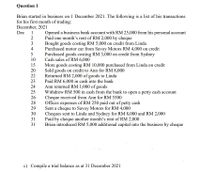
FINANCIAL ACCOUNTING
10th Edition
ISBN: 9781259964947
Author: Libby
Publisher: MCG
expand_more
expand_more
format_list_bulleted
Concept explainers
Topic Video
Question

Transcribed Image Text:Question 1
Brian started in business on 1 December 2021. The following is a list of his transactions
for his first month of trading:
December, 2021
Dec
1
Opened a business bank account with RM 25,000 from his personal account
Paid one month's rent of RM 2,000 by cheque
Bought goods costing RM 5,000 on credit from Linda
Purchased motor car from Savoy Motors RM 4,000 on credit
Purchased goods costing RM 3,000 on credit from Sydney
Cash sales of RM 6,000
More goods costing RM 10,000 purchased from Linda on credit
Sold goods on credit to Ann for RM 8,000
Returned RM 2,000 of goods to Linda
Paid RM 6,000 in cash into the bank
Ann returned RM 1,000 of goods
Withdrew RM 500 in cash from the bank to open a petty cash account
Cheque received from Ann for RM 5500
Offices expenses of RM 250 paid out of petty cash
Sent a cheque to Savoy Motors for RM 4,000
Cheques sent to Linda and Sydney for RM 8,000 and RM 2,000
Paid by cheque another month's rent of RM 2,000
Brian introduced RM 5,000 additional capital into the business by cheque
3
4
5
10
15
20
22
23
24
25
26
28
29
30
31
31
c) Compile a trial balance as at 31 December 2021
Expert Solution
This question has been solved!
Explore an expertly crafted, step-by-step solution for a thorough understanding of key concepts.
Step by stepSolved in 2 steps with 2 images

Knowledge Booster
Learn more about
Need a deep-dive on the concept behind this application? Look no further. Learn more about this topic, accounting and related others by exploring similar questions and additional content below.Similar questions
- hi how do we record this in MYOB. Please help me Transactions from early January 2021 2 Obtained a loan of $14,000 from Uncle Oliver (a family relative of Beatrice Reed) at a simple interest rate of 10% per year, Cheque No. 145, ID #CR000001. The principal and interest on the loan are payable in six months time. 3 Received Cheque No. 227 from Pikea for the full amount outstanding on their account, ID #CR000002. 4 Issued Cheque No. 4098 for $10,065 to Mega Tech in payment of Purchase #303 (Supplier Inv#230). 4 Purchased 9 units MePod multimedia players from Pony at $979 each (includes 10% GST), Purchase #306, Supplier Inv#328. Issued Cheque No. 4099 for $3,900 to this supplier for this particular invoice at the time of the purchase. 4 Issued Cheque No. 4100 for $1,320 (includes 10% GST) to Discount Office Supplies for the cash purchase of office supplies. 6 Sold the following items on credit to Jerry Technology, Invoice #3284: 3 units BG90 plasma televisions for…arrow_forwardPost to the general ledgerarrow_forwardUsing the three column cash book, show the closing balances for; a) Cash b) Bank c) Discount allowed d) Discount Receivedarrow_forward
arrow_back_ios
arrow_forward_ios
Recommended textbooks for you

 AccountingAccountingISBN:9781337272094Author:WARREN, Carl S., Reeve, James M., Duchac, Jonathan E.Publisher:Cengage Learning,
AccountingAccountingISBN:9781337272094Author:WARREN, Carl S., Reeve, James M., Duchac, Jonathan E.Publisher:Cengage Learning, Accounting Information SystemsAccountingISBN:9781337619202Author:Hall, James A.Publisher:Cengage Learning,
Accounting Information SystemsAccountingISBN:9781337619202Author:Hall, James A.Publisher:Cengage Learning, Horngren's Cost Accounting: A Managerial Emphasis...AccountingISBN:9780134475585Author:Srikant M. Datar, Madhav V. RajanPublisher:PEARSON
Horngren's Cost Accounting: A Managerial Emphasis...AccountingISBN:9780134475585Author:Srikant M. Datar, Madhav V. RajanPublisher:PEARSON Intermediate AccountingAccountingISBN:9781259722660Author:J. David Spiceland, Mark W. Nelson, Wayne M ThomasPublisher:McGraw-Hill Education
Intermediate AccountingAccountingISBN:9781259722660Author:J. David Spiceland, Mark W. Nelson, Wayne M ThomasPublisher:McGraw-Hill Education Financial and Managerial AccountingAccountingISBN:9781259726705Author:John J Wild, Ken W. Shaw, Barbara Chiappetta Fundamental Accounting PrinciplesPublisher:McGraw-Hill Education
Financial and Managerial AccountingAccountingISBN:9781259726705Author:John J Wild, Ken W. Shaw, Barbara Chiappetta Fundamental Accounting PrinciplesPublisher:McGraw-Hill Education


Accounting
Accounting
ISBN:9781337272094
Author:WARREN, Carl S., Reeve, James M., Duchac, Jonathan E.
Publisher:Cengage Learning,

Accounting Information Systems
Accounting
ISBN:9781337619202
Author:Hall, James A.
Publisher:Cengage Learning,

Horngren's Cost Accounting: A Managerial Emphasis...
Accounting
ISBN:9780134475585
Author:Srikant M. Datar, Madhav V. Rajan
Publisher:PEARSON

Intermediate Accounting
Accounting
ISBN:9781259722660
Author:J. David Spiceland, Mark W. Nelson, Wayne M Thomas
Publisher:McGraw-Hill Education

Financial and Managerial Accounting
Accounting
ISBN:9781259726705
Author:John J Wild, Ken W. Shaw, Barbara Chiappetta Fundamental Accounting Principles
Publisher:McGraw-Hill Education